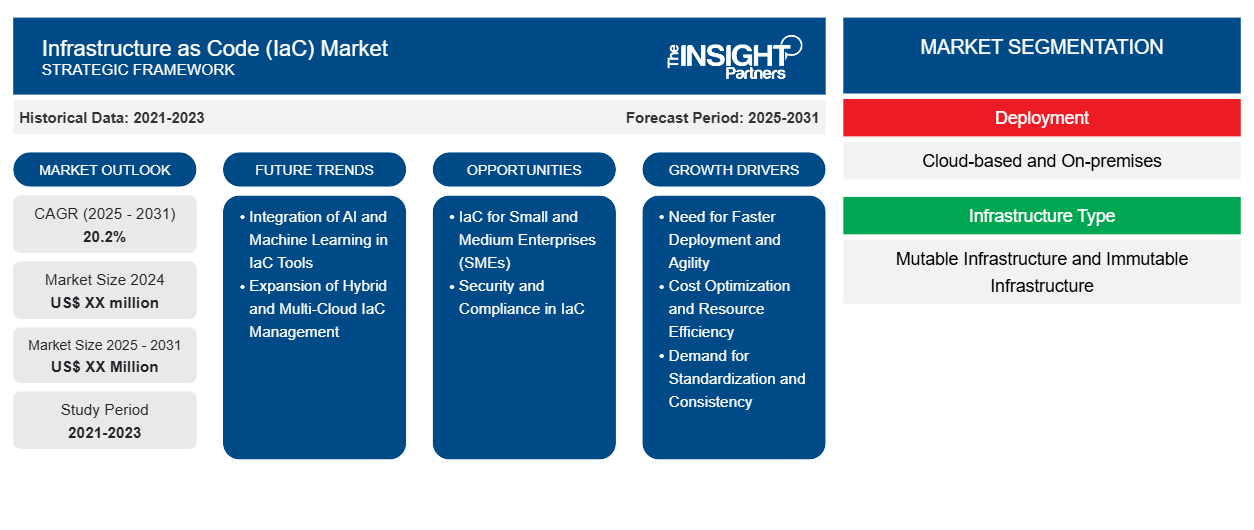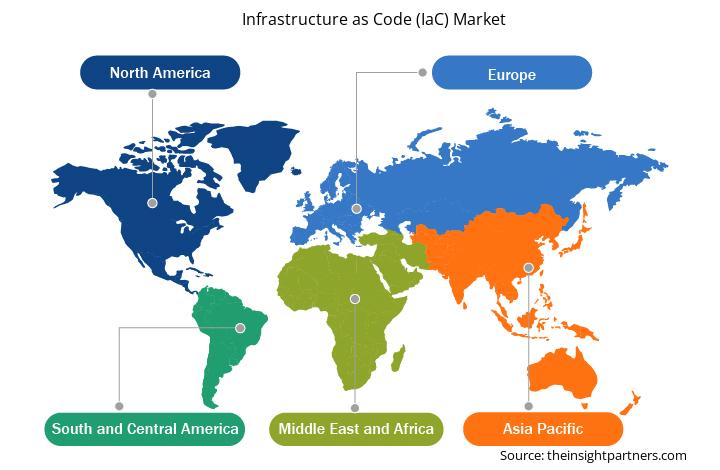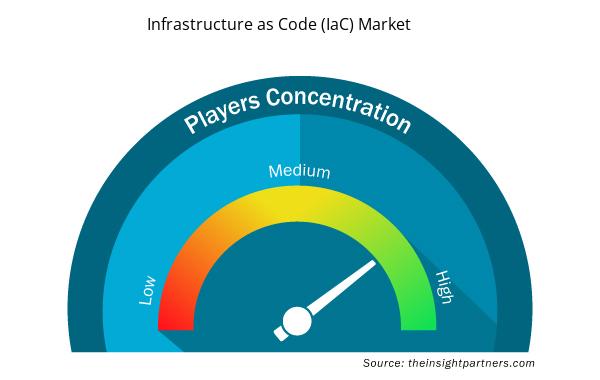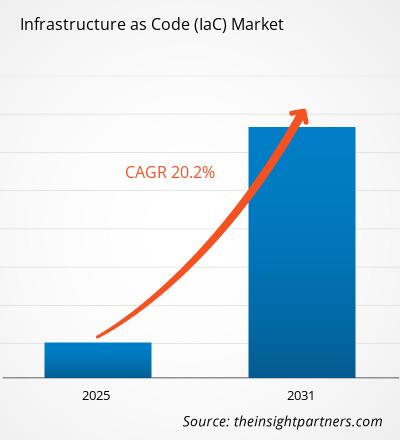Für den Markt für Infrastructure as Code (IaC) wird von 2025 bis 2031 eine durchschnittliche jährliche Wachstumsrate (CAGR) von 20,2 % erwartet, wobei die Marktgröße von XX Millionen US-Dollar im Jahr 2024 auf XX Millionen US-Dollar im Jahr 2031 anwachsen wird.
Der Bericht ist segmentiert nach Bereitstellung (Cloud-basiert und lokal), nach Infrastrukturtyp (veränderliche und unveränderliche Infrastruktur), nach Ansatz (imperativ und deklarativ) und nach Endnutzer (BFSI, Einzelhandel, Behörden, Fertigung, IT & Telekommunikation, Gesundheitswesen und andere). Die globale Analyse ist weiter nach Regionen und wichtigen Ländern aufgeschlüsselt. Der Bericht gibt den Wert in USD für die oben genannten Analysen und Segmente an.
Zweck des Berichts
Der Bericht „Infrastructure as Code (IaC) Market“ von The Insight Partners beschreibt die aktuelle Marktsituation und das zukünftige Wachstum sowie die wichtigsten Treiber, Herausforderungen und Chancen. Er liefert Einblicke für verschiedene Geschäftsinteressenten, beispielsweise:
- Technologieanbieter/-hersteller: Um die sich entwickelnde Marktdynamik zu verstehen und die potenziellen Wachstumschancen zu kennen, können sie fundierte strategische Entscheidungen treffen.
- Investoren: Um eine umfassende Trendanalyse hinsichtlich der Marktwachstumsrate, der finanziellen Marktprognosen und der Chancen entlang der Wertschöpfungskette durchzuführen.
- Regulierungsbehörden: Sie regulieren die Richtlinien und polizeilichen Aktivitäten auf dem Markt mit dem Ziel, Missbrauch zu minimieren, das Vertrauen der Anleger zu wahren und die Integrität und Stabilität des Marktes aufrechtzuerhalten.
Marktsegmentierung für Infrastructure as Code (IaC)
Einsatz
- Cloudbasiert und vor Ort
Infrastrukturtyp
- Veränderliche Infrastruktur und unveränderliche Infrastruktur
Ansatz
- Imperativ und Deklarativ
Endbenutzer
- BFSI
- Einzelhandel
- Regierung
- Herstellung
- IT und Telekommunikation
- Gesundheitspflege
Passen Sie diesen Bericht Ihren Anforderungen an
Sie erhalten kostenlos Anpassungen an jedem Bericht, einschließlich Teilen dieses Berichts oder einer Analyse auf Länderebene, eines Excel-Datenpakets sowie tolle Angebote und Rabatte für Start-ups und Universitäten
Markt für Infrastruktur als Code (IaC): Strategische Einblicke

- Informieren Sie sich über die wichtigsten Markttrends in diesem Bericht.Dieses KOSTENLOSE Beispiel umfasst Datenanalysen, von Markttrends bis hin zu Schätzungen und Prognosen.
Wachstumstreiber für den Markt für Infrastructure as Code (IaC)
- Bedarf an schnellerer Bereitstellung und Agilität: Unternehmen konzentrieren sich zunehmend auf die Beschleunigung von Softwareentwicklungszyklen und die Verbesserung der Markteinführungszeit. IaC ermöglicht eine schnellere Bereitstellung, Implementierung und Skalierung der Infrastruktur und erleichtert DevOps und Continuous Delivery Pipelines. Dieses Streben nach Agilität und optimierten Abläufen in IT-Umgebungen beflügelt den IaC-Markt erheblich.
- Kostenoptimierung und Ressourceneffizienz: IaC automatisiert das Infrastrukturmanagement, reduziert den Bedarf an manuellen Eingriffen und minimiert die Ressourcenverschwendung. Dies führt zu verbesserter Ressourceneffizienz, Kosteneinsparungen und einer besseren Nutzung von Cloud-Diensten. Da Unternehmen ihre Betriebskosten optimieren möchten, steigt die Nutzung von IaC.
- Bedarf an Standardisierung und Konsistenz: IaC ermöglicht die Standardisierung von Infrastrukturbereitstellungen in verschiedenen Umgebungen (z. B. Entwicklung, Test, Produktion). Durch die Kodifizierung von Konfigurationen werden konsistente Infrastruktur-Setups sichergestellt, Konfigurationsabweichungen und -fehler reduziert und die Gesamtsystemzuverlässigkeit verbessert. Dieser Bedarf an konsistenten und wiederholbaren Prozessen treibt die Einführung von IaC voran.
Zukünftige Trends auf dem Infrastructure-as-Code-Markt (IaC)
- Integration von KI und maschinellem Lernen in IaC-Tools: Die Integration von KI- und maschinellem Lernen in IaC-Lösungen wird voraussichtlich zunehmen. Diese Technologien können die Ressourcenzuweisung optimieren, den Infrastrukturbedarf vorhersagen und die Anomalieerkennung automatisieren. KI-gesteuerte IaC-Tools steigern die Betriebseffizienz, reduzieren Ausfallzeiten und optimieren die Verwaltung komplexer Infrastrukturumgebungen.
- Ausbau des Hybrid- und Multi-Cloud-IaC-Managements: Mit der Einführung von Hybrid- und Multi-Cloud-Strategien wird die Verwaltung der Infrastruktur in verschiedenen Cloud-Umgebungen komplexer. IaC-Lösungen werden weiterentwickelt, um ein nahtloses Management über Hybrid- und Multi-Cloud-Architekturen hinweg zu unterstützen und Unternehmen die Bereitstellung, Konfiguration und Verwaltung von Infrastrukturen über verschiedene Cloud-Anbieter und lokale Umgebungen hinweg zu ermöglichen.
Marktchancen für Infrastructure as Code (IaC)
- IaC für kleine und mittlere Unternehmen (KMU): Große Unternehmen haben bereits IaC-Lösungen eingeführt. Es bietet sich jedoch die Möglichkeit, maßgeschneiderte, benutzerfreundliche IaC-Tools für kleine und mittlere Unternehmen (KMU) bereitzustellen. Diese Lösungen können KMU dabei unterstützen, das Infrastrukturmanagement zu automatisieren, manuelle Eingriffe zu reduzieren und Konsistenz zu gewährleisten, ohne dass umfangreiches technisches Fachwissen oder hohe Budgets erforderlich sind. Dadurch wird IaC einem breiteren Markt zugänglich gemacht.
- Sicherheit und Compliance im IaC: Da IaC-Tools die Infrastrukturbereitstellung automatisieren, müssen sie auch Sicherheit und Compliance gewährleisten. Das Angebot von IaC-Lösungen, die Best Practices für Sicherheit, Schwachstellen-Scans und Compliance-Prüfungen integrieren, eröffnet Chancen in Branchen wie dem Finanzwesen, dem Gesundheitswesen und dem öffentlichen Dienst, in denen Sicherheit und die Einhaltung gesetzlicher Vorschriften von entscheidender Bedeutung sind. Dieser Nischenmarkt wird deutlich wachsen, da Sicherheit im Infrastrukturmanagement zu einem zentralen Anliegen wird.
Regionale Einblicke in den Markt für Infrastruktur als Code (IaC)
Die Analysten von Insight Partners haben die regionalen Trends und Faktoren, die den Infrastructure-as-Code-Markt (IaC) im Prognosezeitraum beeinflussen, ausführlich erläutert. In diesem Abschnitt werden auch die Marktsegmente und die geografische Lage von Infrastructure-as-Code (IaC) in Nordamerika, Europa, Asien-Pazifik, dem Nahen Osten und Afrika sowie Süd- und Mittelamerika erläutert.

- Erhalten Sie regionale Daten zum Infrastructure as Code (IaC)-Markt
Umfang des Marktberichts zu Infrastructure as Code (IaC)
| Berichtsattribut | Details |
|---|---|
| Marktgröße im Jahr 2024 | XX Millionen US-Dollar |
| Marktgröße bis 2031 | XX Millionen US-Dollar |
| Globale CAGR (2025 – 2031) | 20,2 % |
| Historische Daten | 2021-2023 |
| Prognosezeitraum | 2025–2031 |
| Abgedeckte Segmente | Nach Bereitstellung
|
| Abgedeckte Regionen und Länder | Nordamerika
|
| Marktführer und wichtige Unternehmensprofile |
|
Marktteilnehmerdichte für Infrastructure as Code (IaC): Auswirkungen auf die Geschäftsdynamik
Der Markt für Infrastructure as Code (IaC) wächst rasant. Die steigende Endnutzernachfrage ist auf Faktoren wie veränderte Verbraucherpräferenzen, technologische Fortschritte und ein stärkeres Bewusstsein für die Produktvorteile zurückzuführen. Mit der steigenden Nachfrage erweitern Unternehmen ihr Angebot, entwickeln Innovationen, um den Verbraucherbedürfnissen gerecht zu werden, und nutzen neue Trends, was das Marktwachstum weiter ankurbelt.
Die Marktteilnehmerdichte beschreibt die Verteilung der in einem bestimmten Markt oder einer bestimmten Branche tätigen Unternehmen. Sie gibt an, wie viele Wettbewerber (Marktteilnehmer) in einem bestimmten Marktraum im Verhältnis zu dessen Größe oder Gesamtmarktwert präsent sind.
Die wichtigsten Unternehmen, die auf dem Infrastructure-as-Code-Markt (IaC) tätig sind, sind:
- IBM
- Microsoft
- AWS
- Orakel
- Hashicorp Terraform
Haftungsausschluss : Die oben aufgeführten Unternehmen sind nicht in einer bestimmten Reihenfolge aufgeführt.

- Überblick über die wichtigsten Akteure auf dem Infrastructure as Code (IaC)-Markt
Wichtige Verkaufsargumente
- Umfassende Abdeckung: Der Bericht deckt die Analyse von Produkten, Diensten, Typen und Endbenutzern des Infrastructure as Code (IaC)-Marktes umfassend ab und bietet eine ganzheitliche Landschaft.
- Expertenanalyse: Der Bericht basiert auf dem umfassenden Verständnis von Branchenexperten und Analysten.
- Aktuelle Informationen: Der Bericht gewährleistet Geschäftsrelevanz durch die Berichterstattung über aktuelle Informationen und Datentrends.
- Anpassungsoptionen: Dieser Bericht kann angepasst werden, um den spezifischen Kundenanforderungen gerecht zu werden und die Geschäftsstrategien optimal anzupassen.
Der Forschungsbericht zum Infrastructure-as-Code-Markt (IaC) kann daher dazu beitragen, die Branchensituation und die Wachstumsaussichten zu entschlüsseln und zu verstehen. Obwohl es einige berechtigte Bedenken gibt, überwiegen die Vorteile dieses Berichts tendenziell die Nachteile.
- Historische Analyse (2 Jahre), Basisjahr, Prognose (7 Jahre) mit CAGR
- PEST- und SWOT-Analyse
- Marktgröße Wert/Volumen – Global, Regional, Land
- Branche und Wettbewerbsumfeld
- Excel-Datensatz



Report Coverage
Revenue forecast, Company Analysis, Industry landscape, Growth factors, and Trends

Segment Covered
This text is related
to segments covered.

Regional Scope
North America, Europe, Asia Pacific, Middle East & Africa, South & Central America

Country Scope
This text is related
to country scope.
Häufig gestellte Fragen
Some of the customization options available based on the request are an additional 3–5 company profiles and country-specific analysis of 3–5 countries of your choice. Customizations are to be requested/discussed before making final order confirmation# as our team would review the same and check the feasibility
The report can be delivered in PDF/PPT format; we can also share excel dataset based on the request
Integration of AI and Machine Learning in IaC Tools and Expansion of Hybrid and Multi-Cloud IaC Management are anticipated to play a significant role in the global Infrastructure as Code (IaC) market in the coming years
Need for Faster Deployment and Agility and Cost Optimization and Resource Efficiency are the major factors driving the Infrastructure as Code (IaC) market
The global infrastructure as code (iac) marketis expected to grow at a CAGR of 20.2% from 2024 to 2031
Trends and growth analysis reports related to Technology, Media and Telecommunications : READ MORE..
The Insight Partners performs research in 4 major stages: Data Collection & Secondary Research, Primary Research, Data Analysis and Data Triangulation & Final Review.
- Data Collection and Secondary Research:
As a market research and consulting firm operating from a decade, we have published and advised several client across the globe. First step for any study will start with an assessment of currently available data and insights from existing reports. Further, historical and current market information is collected from Investor Presentations, Annual Reports, SEC Filings, etc., and other information related to company’s performance and market positioning are gathered from Paid Databases (Factiva, Hoovers, and Reuters) and various other publications available in public domain.
Several associations trade associates, technical forums, institutes, societies and organization are accessed to gain technical as well as market related insights through their publications such as research papers, blogs and press releases related to the studies are referred to get cues about the market. Further, white papers, journals, magazines, and other news articles published in last 3 years are scrutinized and analyzed to understand the current market trends.
- Primary Research:
The primarily interview analysis comprise of data obtained from industry participants interview and answers to survey questions gathered by in-house primary team.
For primary research, interviews are conducted with industry experts/CEOs/Marketing Managers/VPs/Subject Matter Experts from both demand and supply side to get a 360-degree view of the market. The primary team conducts several interviews based on the complexity of the markets to understand the various market trends and dynamics which makes research more credible and precise.
A typical research interview fulfils the following functions:
- Provides first-hand information on the market size, market trends, growth trends, competitive landscape, and outlook
- Validates and strengthens in-house secondary research findings
- Develops the analysis team’s expertise and market understanding
Primary research involves email interactions and telephone interviews for each market, category, segment, and sub-segment across geographies. The participants who typically take part in such a process include, but are not limited to:
- Industry participants: VPs, business development managers, market intelligence managers and national sales managers
- Outside experts: Valuation experts, research analysts and key opinion leaders specializing in the electronics and semiconductor industry.
Below is the breakup of our primary respondents by company, designation, and region:

Once we receive the confirmation from primary research sources or primary respondents, we finalize the base year market estimation and forecast the data as per the macroeconomic and microeconomic factors assessed during data collection.
- Data Analysis:
Once data is validated through both secondary as well as primary respondents, we finalize the market estimations by hypothesis formulation and factor analysis at regional and country level.
- Macro-Economic Factor Analysis:
We analyse macroeconomic indicators such the gross domestic product (GDP), increase in the demand for goods and services across industries, technological advancement, regional economic growth, governmental policies, the influence of COVID-19, PEST analysis, and other aspects. This analysis aids in setting benchmarks for various nations/regions and approximating market splits. Additionally, the general trend of the aforementioned components aid in determining the market's development possibilities.
- Country Level Data:
Various factors that are especially aligned to the country are taken into account to determine the market size for a certain area and country, including the presence of vendors, such as headquarters and offices, the country's GDP, demand patterns, and industry growth. To comprehend the market dynamics for the nation, a number of growth variables, inhibitors, application areas, and current market trends are researched. The aforementioned elements aid in determining the country's overall market's growth potential.
- Company Profile:
The “Table of Contents” is formulated by listing and analyzing more than 25 - 30 companies operating in the market ecosystem across geographies. However, we profile only 10 companies as a standard practice in our syndicate reports. These 10 companies comprise leading, emerging, and regional players. Nonetheless, our analysis is not restricted to the 10 listed companies, we also analyze other companies present in the market to develop a holistic view and understand the prevailing trends. The “Company Profiles” section in the report covers key facts, business description, products & services, financial information, SWOT analysis, and key developments. The financial information presented is extracted from the annual reports and official documents of the publicly listed companies. Upon collecting the information for the sections of respective companies, we verify them via various primary sources and then compile the data in respective company profiles. The company level information helps us in deriving the base number as well as in forecasting the market size.
- Developing Base Number:
Aggregation of sales statistics (2020-2022) and macro-economic factor, and other secondary and primary research insights are utilized to arrive at base number and related market shares for 2022. The data gaps are identified in this step and relevant market data is analyzed, collected from paid primary interviews or databases. On finalizing the base year market size, forecasts are developed on the basis of macro-economic, industry and market growth factors and company level analysis.
- Data Triangulation and Final Review:
The market findings and base year market size calculations are validated from supply as well as demand side. Demand side validations are based on macro-economic factor analysis and benchmarks for respective regions and countries. In case of supply side validations, revenues of major companies are estimated (in case not available) based on industry benchmark, approximate number of employees, product portfolio, and primary interviews revenues are gathered. Further revenue from target product/service segment is assessed to avoid overshooting of market statistics. In case of heavy deviations between supply and demand side values, all thes steps are repeated to achieve synchronization.
We follow an iterative model, wherein we share our research findings with Subject Matter Experts (SME’s) and Key Opinion Leaders (KOLs) until consensus view of the market is not formulated – this model negates any drastic deviation in the opinions of experts. Only validated and universally acceptable research findings are quoted in our reports.
We have important check points that we use to validate our research findings – which we call – data triangulation, where we validate the information, we generate from secondary sources with primary interviews and then we re-validate with our internal data bases and Subject matter experts. This comprehensive model enables us to deliver high quality, reliable data in shortest possible time.

 Holen Sie sich ein kostenloses Muster für diesen Bericht
Holen Sie sich ein kostenloses Muster für diesen Bericht